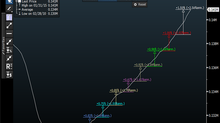Dispelling a Myth, Or Two, Or Three
Encountering opinions on financial and social media means running into a lot of misconceptions about the economy. How they gain so much currency is beyond me, but once they spread, it's almost impossible to get rid of them. One of them is that there is a class of "Discouraged Workers" who are not counted by the Department of Labor, and therefore, the employment numbers are falsified. They are people who have supposedly just thrown up their hands, and stopped looking for work altogether, and have been effectively "disappeared" by the government. There's only one problem with this narrative: You can't stay discouraged for too long, or you will either starve or get evicted. No doubt people do give up after a frustrating time seeking employment, but I doubt they're out of the ring for too long. Economist Roger Farmer wrote about this awhile ago.
"According to a popular narrative, labor force participation is low because of 'discouraged workers'. These are people who would really like to be working but who have dropped out the labor force because they cannot find a job. What is the evidence for the 'discouraged worker'? In my view; not much."
And he's right. For one thing, the BLS indeed DOES count "Discouraged Workers" as part of their U-4 measurement, so they haven't been ignored. By their estimation, they constitute less than six tenths of one percent of the entire workforce population. Not enough to move the needle. But aside from that, the paranoia expressed is mind boggling. No one is left out out of the broad survey conducted every month:
"Each month, highly trained and experienced Census Bureau employees contact the 60,000 eligible sample households and ask about the labor force activities (job holding and job seeking) or non-labor force status of the members of these households during the survey reference week. These are live interviews conducted either in person or over the phone. During the first interview of a household, the Census Bureau interviewer prepares a roster of the household members, including key personal characteristics such as age, sex, race, Hispanic ethnicity, marital status, educational attainment, veteran status, and so on. The information is collected using a computerized questionnaire."
That is a very large sample size, and it is a good thing that we dedicate the resources to track this as accurately as we can. Not only is it useful for public policy, but the private sector depends on the data to make decisions as well. But according to popular myth, there must be millions of unemployed ghosts wandering the land.
Another one of my favorite slogans is that our national debt obligations "crowd out" private sector investment. This trope is practically totemic with debt scolds, but having lived through booms and busts, surpluses and debts, it occurred to me there was no truth in it. So I decided to graph it:

All three lines are benchmarked as a percentage of GDP, as they properly should. The blue line shows Gross Private Domestic Investment, and wouldn't you know it, there doesn't seem to be any effect on private investment we can draw from either the level of Total Public Debt or the holdings of Central Bank Assets. So why do people say they do? Because they think it will get them a tax cut.
Last but not least, is the effect interest rates supposedly have on savers. So much twaddle has been written on this subject since the GFC brought us zero bound rates. Let's look at the data.

OK, kids, the Black line is the Fed Funds rate and the Personal Savings Rate has been overlayed both as a straight percentage, as well as a percentage of disposable income, which tend to mirror each other for the most part. Some of you may remember this as the "Recession Indicator" I posted last year, which shows that since the end of Bretton Woods (1971), whenever the Fed Funds rate crosses below the savings rate, we go into recession. There's another way of looking at it. The canaries in the coal mine are getting nervous, and have begun to husband their assets. The birds don't give a rat's behind where rates are sitting, they're just scared, that's all. So the Fed starts loosening as it sees the economy slowing, and people stop spending. Whether the rate is 5.00% or next to nothing, people don't care. They save less once they get comfortable with the economy, as they did in the late 90s, the 2003-2006 period, and....now.
And that's it for dispelling myths, which the dictionary defines as "a widely held but false belief or idea." Given the cacophony of today's media swirl, there must be thousands of them.













